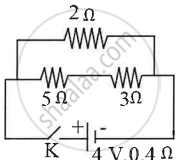Advertisements
Advertisements
Question
Two wires of the same material and same length have radii 1 mm and 2 mm respectively. Compare their resistances.
Solution
`"R"_1 ∝ 1/(pir_1^2)`
`"R"_2 ∝ 1/(pir_2^2)`
∴ `"R"_1/"R"_2 = (pir_2^2)/(pir_1^2)`
∴ `"R"_1 : "R"_2 = r_2^2 : r_1^2`
= 22 : 12
= 4 : 1
APPEARS IN
RELATED QUESTIONS
Two copper wires are of the same length, but one is thicker than the other. Which wire will have more resistance?
How does the resistance of a wire depend on its radius? Explain your answer.
Exercise.
The values of current (I) flowing through a resistor for various potential differences V across the resistor are given below. What is the value of resistor?
| I (ampere) | 0.5 | 1.0 | 2.0 | 3.0 | 4.0 |
| V (volt) | 1.6 | 3.4 | 6.7 | 10.2 | 13.2 |
The effective resistance of three resistors connected in series is lesser than the lowest of the individual resistances.
An electric bulb is rated ‘240 V, 100 W’.
- What information can you get from the above statement?
- What will happen if this bulb is connected across 220 V?
- Calculate the resistance of the bulb.
- Also find the energy consumed by the bulb in 10 minutes.
The resistance of a straight conductor is independent of ______.
______ is the only non-metal that is a good conductor of electricity.
Three resistors are connected in parallel with a battery. If the current in each resistor is 2A, then the current through the battery will be ______.
The ______ is the measure of opposition offered by the component to the flow of electric current through it.
Observe the given circuit diagram and answer the questions that follow:

- Calculate the resistance of the circuit when the key K completes the circuit.
- Calculate the current through 3Ω resistance when the circuit is complete.
